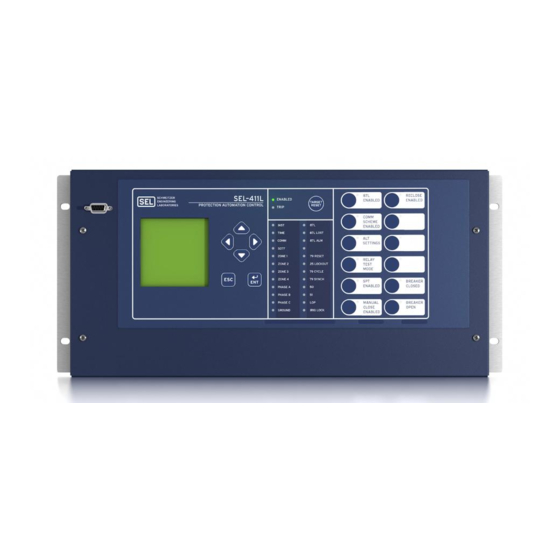
Table of Contents
Advertisement
Application Guide
Testing a Two-Terminal Application
of the SEL-411L in Test Mode
I
NTRODUCTION
The SEL-411L Advanced Line Differential Protection, Automation, and Control System has a
built-in test mode with flexible single-terminal and multiterminal testing options. This mode
allows you to perform acceptance, commissioning, and maintenance testing on a line differential
application that uses SEL-411L Relays in an easy and efficient manner. The TEST 87L
command makes it possible to test the differential element on an in-service line from only one
terminal or from all terminals at the same time (the latter requires the test sets to be satellite-
synchronized).
Figure 1 shows a typical line differential protection arrangement where the exchange of local and
remote operating data between the relays in the scheme takes place over two channels. Bay 1
(Channel 1) uses a dedicated fiber direct connection between the two relays and a channel-based
data synchronization method (ping pong). Bay 2 uses multiplexers to create a hot standby
channel. This has the potential for channel asymmetry, so a time-based synchronization is used
for Channel 2. When external time-based synchronization is used, both SEL-411L Relays must be
connected to an external, high-precision, IEEE C37.118-compliant time source.
This application guide is a test guide for the scenario presented in Figure 1. The goal of this guide
is to provide the ability to test the characteristics of the differential elements in an SEL-411L and
to provide the tools to calculate the currents to be injected into the relay to validate the
differential scheme.
Date Code 20150401
Ashwin Vashist and George Alexander
Bay 1
SEL-411L
Bay 2
Digital
Multiplexer
Figure 1 Typical two-terminal SEL-411L application
Volume I
Dedicated Fiber
Hot Standby
Channel
Digital
Multiplexer
AG2015-12
Bay 1
SEL-411L
Bay 2
SEL Application Guide 2015-12
Advertisement
Table of Contents

Summary of Contents for Schweitzer Engineering Laboratories SEL-411L
- Page 1 This application guide is a test guide for the scenario presented in Figure 1. The goal of this guide is to provide the ability to test the characteristics of the differential elements in an SEL-411L and to provide the tools to calculate the currents to be injected into the relay to validate the differential scheme.
- Page 2 Figure 2 The {RELAY TEST MODE} pushbutton supervises the 87L test mode The function of this pushbutton in the default settings of the SEL-411L is to supervise the Access Level 2 TEST 87L command. The TEST 87L command allows for the testing of the Alpha Plane or the relay differential operating characteristic.
- Page 3 87L watchdog counters cleared =>>| The test mode also allows you to bypass the watchdog timer logic in the SEL-411L and gives you the ability to ramp local and remote currents into the relay in an independently adjustable manner. This provides additional flexibility to find acceptable test points without needing to worry about inhibiting 87L function.
- Page 4 Note: Noticing whether the red and green transmit and receive lights are illuminated on the back of the SEL-411L is one way to verify that the fiber connections on the channel ports on the back of the SEL-411L are correct.
- Page 5 =>>TEST 87L Entering 87L Test Mode Select Test: Characteristic or Loopback (C,L) Test Mode: Single, Multi Terminal, or Disabled (S,M,D) 87L Element: (A,B,C,Q,G) Select one of the 87L differential elements for testing. In the 87L test mode, the normal 87L elements (i.e., 87LA, 87LB, 87LC, 87LQ, and 87LG) are blocked from operating.
- Page 6 When using the single-terminal test mode, the local and remote currents are injected into different phase current inputs of the SEL-411L being tested. The currents used are determined by the element under test. Table 1 shows the analog substitutions to test the phase, ground, and negative- sequence fault quantities.
- Page 7 INGLE ERMINAL AND ULTITERMINAL ROCEDURE Current injection for these tests is based on the differential element selected in the 87L test mode, as described in the previous section. This procedure checks the pickup, radius, and angle settings. The following is a list of the settings that are used and tested in this application guide: •...
- Page 8 INGLE ERMINAL ESTS Pickup Setting Check Step 1. Connect the proper local current source. Start with no current applied. Step 2. Slowly increase the applied local current until Relay Word bit 87TOUT asserts. The pickup value should be within ±5 percent of the value calculated by (1): 87LTAPn •...
- Page 9 Step 7. Assuming that the angles are measured as 0 to +180 degrees and 0 to –180 degrees, respectively, check that the block angle is set within ±5 percent of the angle determined by (3): 87LkA ANG1 ANG2 where: 87LkA is 87LPA for an 87LA, 87LB, or 87LC test; 87LQA for an 87LQ test; and 87LGA for an 87LG test.
- Page 10 87TESTS = S option in test mode, which switches the normal radius and angle settings to secure mode settings. ONCLUSION This application guide provides the tools to test the characteristics of the differential elements of the SEL-411L relay in test mode. SEL Application Guide 2015-12 Date Code 20150401...
- Page 11 ACTORY SSISTANCE We appreciate your interest in SEL products and services. If you have questions or comments, please contact us at: Schweitzer Engineering Laboratories, Inc. 2350 NE Hopkins Court Pullman, WA 99163-5603 USA Telephone: +1.509.332.1890 Fax: +1.509.332.7990 www.selinc.com • info@selinc.com...
- Page 12 © 2015 by Schweitzer Engineering Laboratories, Inc. All rights reserved. All brand or product names appearing in this document are the trademark or registered trademark of their respective holders. No SEL trademarks may be used without written permission. *AG2015-12* SEL products appearing in this document may be covered by U.S.















Need help?
Do you have a question about the SEL-411L and is the answer not in the manual?
Questions and answers